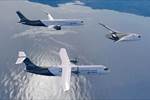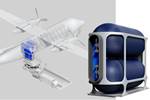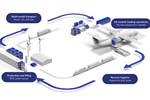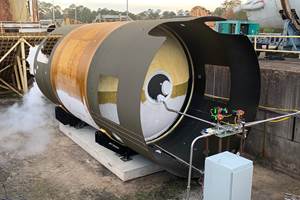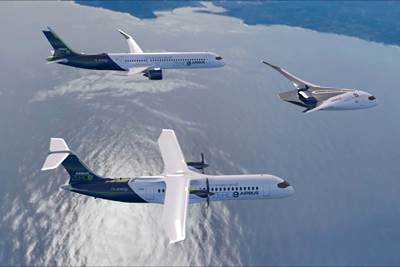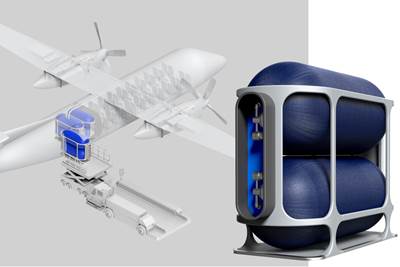ZeroAvia secures additional funding to accelerate hydrogen-powered aviation
Amazon, Shell add to $21.4 million in venture funding plus U.K. government $16.3 million grant for HyFlyer II project to deliver 19-seat H2 aircraft by 2023.
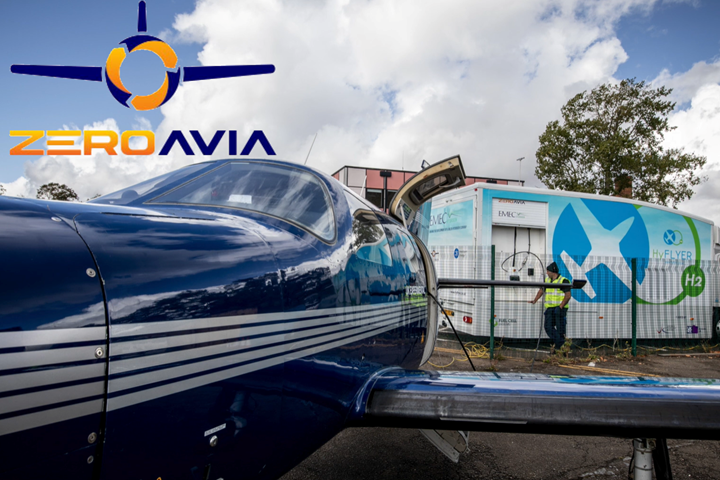
ZeroAvia’s mission to transition the world to zero-emission, hydrogen-fueled flight is aided by $21.4 million in new Series A round funding. Breakthrough Energy Ventures and Ecosystem Integrity Fund led the raise, with follow-on investors Amazon Climate Pledge Fund, Horizons Ventures, Shell Ventures and Summa Equity. In addition, the company established a partnership with British Airways and received approval for new U.K. government funding through the ATI Programme to deliver an additional $16.3 million for a breakthrough 19-seat hydrogen-electric powered aircraft that is market-ready by 2023. This announcement is said to bring total funding to $37.7 million and the total funding since inception to $49.7 million.
The fundraiser allows ZeroAvia to accelerate the development of its hydrogen-electric powertrain further. Specifically, the Series A funds the next phase of the company’s R&D program, which focuses on developing and testing the certification-ready ZA-600 powertrain capable of flying 10-20 seat aircraft up to 500 miles. The investment comes on the heels of the company completing what is said to be the U.K.’s first commercial-scale battery-electric flight in June 2020 and the first flight of the largest hydrogen fuel cell aircraft in September 2020 as part of the HyFlyer I project. ZeroAvia expects a long-distance flight of 250 miles in the next three months.
ZeroAvia offers what it claims is the first practical hydrogen-fueled powertrain technology to replace conventional engines in propeller aircraft resulting in zero-emission, lower noise, lower fuel and maintenance costs and significant total trip cost reduction. Focused on hydrogen aviation solutions that address various markets, ZeroAvia expects to achieve commercialization as early as 2023 and demonstrate flights up to 500 miles in aircraft up to 20 seats. By 2026, ZeroAvia intends to realize flights more than 500 miles range in aircraft with up to 80 seats, and by 2030 over 1,000-mile flights in aircraft with over 100 seats.
“Our most recent milestone achievements are closing the gap for the airline industry to begin its transition away from fossil fuels,” says Val Miftakhov, founder and CEO of ZeroAvia. “In fact, more than ten forward-looking airlines are now gearing up to implement our powertrains when they are ready in 2023. Both aviation and the financial markets are waking up to the idea that hydrogen is the only meaningful path towards large-scale, zero-emission commercial flight. Powering a 100-seat plane on hydrogen is not out of the question. We feel deeply grateful to our top-tier investors for joining us in the next phase of our exciting journey; to bring in a new golden age of aviation.”
This funding, says ZeroAvia, is on the heels of a partnership with British Airways in a project to explore how hydrogen-powered aircraft can play a leading role in the future of sustainable flying. With sustainability of increasing importance at British Airways, the collaboration will embed ZeroAvia in the heart of the airline to work alongside mentors and experts to explore the transformational possibilities of moving from fossil fuels to zero-emission hydrogen to power the airline’s future fleet. The partnership forms part of the International Airlines Group’s Hangar 51 accelerator program.
ZeroAvia was also recently recognized as a TIME Best Invention of 2020 in the experimental category and secured a spot on the Cleantech Group’s 2020 50TOWATCH list, which awards early-stage private companies delivering innovative solutions to combat the climate crisis.
Related Content
On the radar: Cryogenic testing of composites for future hydrogen storage
Netherlands, U.K., France, Germany and the U.S. build up test capability, look at thermoset and thermoplastic composite materials.
Read MoreHexagon Purus opens new U.S. facility to manufacture composite hydrogen tanks
CW attends the opening of Westminster, Maryland, site and shares the company’s history, vision and leading role in H2 storage systems.
Read MoreHonda begins production of 2025 CR-V e:FCEV with Type 4 hydrogen tanks in U.S.
Model includes new technologies produced at Performance Manufacturing Center (PMC) in Marysville, Ohio, which is part of Honda hydrogen business strategy that includes Class 8 trucks.
Read MoreECOHYDRO project to enable recyclable composites for hydrogen storage
With the involvement of two schools from the Institut Mines-Télécom, the 4-year project aims to improve the intrinsic properties of a composite material based on Elium via four concrete demonstrators.
Read MoreRead Next
Airbus reveals new zero-emission concept aircraft
The three concepts — all codenamed ZEROe — each represent a different approach to achieving zero-emission flight. The aircraft could enter service by 2035.
Read MoreCarbon fiber in pressure vessels for hydrogen
The emerging H2 economy drives tank development for aircraft, ships and gas transport.
Read MoreUniversal Hydrogen uses dry braided carbon preform tanks as part of plan to decarbonize aviation
Twin-tank module offers low capex option for regional carriers to convert to clean fuel.
Read More

